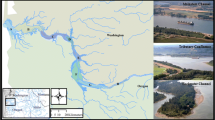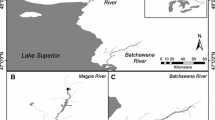Abstract
The relationships among microhabitat use, food habits, conspecific density and recent growth rate for estuarine-dependent juvenile spotted seatrout, Cynoscion nebulosus, and red drum, Sciaenops ocellatus, were studied to determine how nursery habitat influences early growth. Juvenile spotted seatrout and red drum were quantified along the marsh-edge ecotone from multiple drop samples, and their immediate environments characterized by a suite of physical and chemical variables along with substrate type and Spartina stem density. Recent daily growth of individual fish was modeled in a series of multiple regression analyses that considered the relative contributions of food, microhabitat, and conspecific density. The spotted seatrout model (p < 0.0001) included four independent variables, otolith radius, prey diversity, salinity, and a salinity-DO interaction term, and explained 67.9% of the variation in daily growth. All variables were significant (p < 0.05), and regression slopes were positive for all variables except salinity. The red drum model (p > 0.0001) included five independent variables, otolith radius, temperature, salinity, depth and substrate, and explained 63.3% of the variation in daily growth. All variables were significant (p > 0.05), and all regression slopes were positive. Fish size (as estimated by otolith radius) accounted for most of the variance in the spotted seatrout (60.2%) and red drum (44.8%) models, while the remaining environmental variables were significant and responsible for 7.7 and 18.5%, respectively. Density variables were not selected for either model, suggesting that density-dependence was not an important influence on recent daily growth. Generally, physico-chemical variables such as temperature, salinity, and dissolved oxygen contributed more to growth than diet or extrinsic factors such as grass stem density.
Similar content being viewed by others
References cited
Andrews, J.W., T. Murai & G. Gibbons. 1973. The influence of dissolved oxygen on the growth of channel catfish. Trans. Amer. Fish. Soc. 4: 835–838.
Baltz, D.M. 1990. Chapter 18, Autecology. pp. 583–605. In: C.B. Schreck & P.B. Moyle (ed.) Methods for Fish Biology, American Fisheries Society, Bethesda.
Baltz, D.M., P.B. Moyle & N.J. Knight. 1982. Competitive interactions between benthic stream fishes, riffle sculpin, Cottus gulosus, and speckled dace, Rhinichthys osculus. Can. J. Fish. Aquat. Sci. 39: 1502–1511.
Baltz, D.M., C. Rakocinski & J.W. Fleeger 1993 Microhabitat use by marsh-edge fishes in a Louisiana estuary. Env. Biol. Fish. 36: 109–126.
Baltz, D.M., B. Vondracek, L.R. Brown & P.B. Moyle. 1987. Influence of temperature on microhabitat choice of fishes in a California stream. Trans. Amer. Fish. Soc. 116: 12–20.
Bass, R.J. & J.W. Avault, Jr. 1975. Food habits, length-weight relationship, condition factor and growth of juvenile red drum (Sciaenops ocellata) in Louisiana. Trans. Amer. Fish. Soc. 104: 35–45.
Beck, M.W. 1995. Size-specific shelter limitation in stone crabs: a test of the demographic bottleneck hypothesis. Ecology 76: 968–980.
Beckman, D.W. 1989. Age and growth of red drum, Sciaenops ocellatus, and black drum, Pogouius cromis, in the northern Gulf of Mexico, Ph.D. Dissertation, Louisiana State University, Baton Rouge. 162 pp.
Boesch, D.F. & R.E. Turner. 1984. Dependence of fishery species on salt marshes: the role of food and refuge. Estuaries 7: 460–468.
Bovee, K.D. & T. Cochnauer. 1977. Development and evaluation of weighted criteria, probability-of-use curves for instream flow assessments: fisheries. U.S. Fish and Wildlife Service Biological Services Program FWS/OBS-77/63. 39 pp.
Browder, J.A., H.A. Bartley & K.S. Davis. 1985. A probablistic model of the relationship between marshland-water interface and marsh disintegration. Ecological Modelling 29: 245–260.
Brett, J.R. 1979. Environmental factors and growth. pp. 599–675, In: W.S. Hoar, D.J. Randall & J.R. Brett (ed.) Fish Physiology, Volume & Academic Press, New York.
Childers, D.L., J.W. Day, Jr. & R.A. Muller. 1990. Relating climatological forcing to coastal water levels in Louisiana estuaries and the potential importance of El Niño-Southern Oscillation events. Clim. Res. 1: 31–42.
Comyns, B.H., J. Lyczkowski-Shultz, C.F. Rakocinski & J.P. Steen, Jr. 1989. Age and growth of red drum larvae in the North-Central Gulf of Mexico. Trans. Amer. Fish. Soc. 118: 159–167.
Currin, D.M., J.P. Reed & J.M. Miller. 1984. Growth, production, food consumption, and mortality of juvenile spot and croaker: a comparison of tidal and nontidal nursery areas. Estuaries 7: 451–459.
Dagg, M.F. 1988. Physical and biological responses to the passage of a winter storm in the coastal and inner shelf waters of the northern Gulf of Mexico. Continental Shelf Research 8: 167–178.
Durbin, F.G., A.G. Durbin. T.J. Smayda & P.G. Verity. 1983. Food limitation of production by adult Acartia tonsa in Narragansett Bay, Rhode Island. Limnology and Oceanography 28: 1199–1213.
Faush, K.T. 1984. Profitable stream positions for salmonids relating specific growth rate to net energy gain. Can. J. Zool. 62: 441–451.
Faush, K.T. & R.J. White. 1981. Competition between brook trout (Salvelinus fontinalis) and brown trout (Salmo trutta) for positions in a Michigan stream. Can. J. Fish. Aquat. Sci. 38: 1220–1227.
Fraser, D.F. & T.E. Sise, 1980. Observations on stream minnows in a patchy environment: a test of a theory of habitat distribution. Ecology 61: 790–797.
Fretwell, S. 1972. Populations in a seasonal environment. Princeton University Press, Princeton. 217 pp.
Fudge, H. 1968. Biochemical analysis of preserved zooplankton. Nature 219: 380–381.
Haake, W., C.A. Wilson & J.M. Dean. 1982. A technique for the examination of otoliths with applications to larval fishes. pp. 12–15. In: C.F. Bryan, J.V. Conner & F.M. Truesdale (ed.) Proc. of the 5th Annual Larval Fish Conference, Baton Rouge.
Hairston, N.G., Sr. 1989. Ecological experiments: purpose, design, and execution. Cambridge University Press, Cambridge, 370 pp.
Hettler, W.E. Jr. 1989a Food habits of juveniles of spotted sea-trout and gray snapper in western Florida Bay. Bull. Mar. Sci. 44: 155–162.
Hettler, W.E. Jr. 1989b. Nekton use of regularty-flooded saltmarsh cordgrass habitat in North Carolina, U.S.A., Mar. Ecol. Prog. Ser. 56: 111–118.
Hurlbert, S.H. 1981. A gentile depilation of the niche: Dicean resource sets in resource hyperspace. Evol. Theory 5: 177–184.
Hurlbert, S.H. 1984. Pseudoreplication and the design of ecological field experiments. Ecol. Monogr. 54: 187–211.
Jobling, M. 1981. Temperature tolerance and the final preferendum — rapid methods for the assessment of optimum growth temperatures. J. Fish Biol. 19: 439–455.
Jobling, M. 1994. Fish bioenergeties. Chapman and Hall, London, 309 pp.
Johnson, R.A. & D.W. Wichern. 1988. Applied multivariate statistical analysis. 2nd. ed. Prentice Hall, Englewood Cliffs, 607 pp.
Juanes, F. & D.O. Conover. 1994. Rapid growth, high feeding rates, and early piscivory in young-of-the-year bluefish (Pomatomus saltatrix). Can. J. Fish. Aquat. Sci. 51: 1752–1761.
Kneib, R.T. 1987. Predation risk and use of interfidal habitats by young fishes and shrimp. Ecology 68: 379–386.
Kneib, R.T. 1993. Growth and mortality in successive cohorts of fish larvae within an estuarine nursery. Mar. Ecol. Prog. Ser. 94: 115–127.
Lankford, T.E. & T.E. Targett. 1994. Suitability of estuarine nursery zones for juvenile weakfish (Cynoscion regalis): effects of temperature and salinity on feeding, growth, and survival. Mar. Biol. 119: 611–620.
Lorica, M.F.P.G. 1988. The age and growth of juvenile spotted seatrout, Cynoscion nebulosus, in coastal Louisiana. Masters Thesis, Louisiana State University, Baton Rouge, 75 pp.
Magnuson, J.J. 1991. Fish and fisheries ecology. Ecological Applications 1: 13–26.
Magnuson, J.J., L.B. Crowder & P.A. Medvick. 1979. Temperature as an ecological resource. Amer. Zool. 19: 331–343.
Malloy, K.D. & T.E. Targett. 1991. Feeding, growth and survival of juvenile summer flounder Paralichthys dentatus — experimental analysis of the effects of temperature and salinity. Mar. Ecol. Prog. Ser. 72: 213–223.
Margalef, R. 1968. Perspectives in ecological theory. University of Chicago Press, Chicago. 111 pp.
Mason, W.T., Jr. & S.A. Zengel. 1996. Foods of juvenile spotted scatrout in seagrasses at Seahorse Key, Florida. Gulf of Mexico Science 1996: 89–104.
Mayr, E. 1961. Cause and effect in biology. Science 134: 1501–1506.
McIvor, C.C. & W.F. Odum. 1988. Food, predation risk, and microhabitat selection in a marsh fish assemblage. Ecology 69: 1341–1351.
McMichael, R.H. & K.M. Peters. 1989. Early life history of spotted seatrout, Cynoscion nebulosus (Pisces: Sciaenidae), in Tampa Bay, Florida. Estuaries 12: 98–110.
Miller, J.M., J.S. Burke & G.R. Fitzhugh. 1991. Early life history patterns of Atlantic North American flatfish: likely (and unlikely) factors controlling recruitment. Neth. J. Sea Res. 27: 261–275.
Neter, J., W. Wasserman & M.H. Kutner. 1989. Applied linear regression models, 2nd ed. Irwin, Homewood. 667 pp.
Pearcy, W.G. & S.S. Myers. 1974. Larval fishes of Yaquina Bay, Oregon: a nursery ground for marine fishes? U.S. Fish. Bull. 72: 201–213.
Peters, K.M. & R.H. McMichael. 1987. Early life history of the red drum, Sciaenops ocellatus (Pisces: Sciaenidae), in Tampa Bay, Florida. Estuaries 10: 92–107.
Rakocinski, C., D.M. Baltz & J.W. Fleeger. 1992. Correspondence between environmental gradients and the community structure of marsh-edge fishes in a Louisiana estuary. Mar. Ecol. Prog. Ser. 80: 135–148.
Rothschild, B.J. 1986. Dynamics of marine fish populations. Harvard University Press, Cambridge. 277 pp.
Rozas, L.P., C.C. McIvor & W.E. Odum. 1988. Intertidal rivulets and creekbanks: corridors between tidal creeks and marshes. Mar. Ecol. Prog. Ser. 47: 303–307.
SAS Inst. 1985. SAS/STAT guide for personal computers, Version 6. SAS Institute, Inc., Cary.
Sasser, C.E. 1977. Distribution of vegetation in Louisiana coastal marshes as response to tidal flooding. Masters Thesis, Louisiana State University, Baton Rouge. 40 pp.
Sogard, S.M. 1992. Variability in growth rates of juvenile fishes in different estuarine habitats. Mar. Ecol. Prog. Ser. 85: 35–53.
Sogard, S.M. 1994. Use of suboptimal foraging habitats by fishes: consequences to growth and survival. pp. 103–132. In: D.J. Stouder, K.L. Fresh & R.J. Feller (ed.) Theory and Application of Fish Feeding Ecology, Belle W. Baruch Libr. Mar. Sci. 18, University of South Carolina Press, Columbia.
Sogard, S.M. & B.L. Olla. 1993. The influence of predator presence on utilization of artificial seagrass habitats by juvenile walleye pollock, Theragra chalcogramma. Env. Biol. Fish. 37: 57–65.
Toepfer, C.S. & J.W. Fleeger. 1995. Diet of juvenile fishes (Citharichthys spilopterus, Symphurus plagiusa, and Gobionellus beleosoma). Bull. Mar. Sci. 56: 238–249.
Turner, R.E. 1997. Wetland loss in the northern Gulf of Mexico: multiple working bypotheses. Estuaries 20: 1–13.
Walters, C.J. & F. Juanes. 1993. Recruitment limitation as a consequence of natural selection for use of restricted feeding habitats and predation risk taking by juvenile fishes. Can. J. Fish. Aquat. Sci. 50: 2058–2070.
Werner, E.E., D.J. Hall, D.R. Laughlin, D.J. Wagner, L.A. Wilsmann & F.C. Funk. 1977. Habitat partitioning in a freshwater fish community. J. Fish. Res. Board Can. 34: 360–370.
Wiens, J.A. 1977. On competition and variable environments. Amer. Scientist 65: 590–597.
Wilson, C.A., D.W. Beckman & J.M. Dean. 1987. Calcein as a fluorescent marker of otoliths of larval and juvenile fish. Trans. Amer. Fish. Soc. 116: 688–670.
Wooton, R.J. 1990. Ecology of teleost fishes. Chapman & Hill, New York. 404 pp.
Yablokov, A.V. 1974. Variability in mammals. Amerind Publishing Comp., Springfield. 350 pp.
Zimmerman, R.J. & T. Minello. 1984. Densities of Penaeus aztecus, Penaeus setiferus, and other natant macrofauna in a Texas salt marsh. Estuaries 7: 421–433.
Author information
Authors and Affiliations
Rights and permissions
About this article
Cite this article
Baltz, D.M., Fleeger, J.W., Rakocinski, C.F. et al. Food, density, and microhabitat: factors affecting growth and recruitment potential of juvenile saltmarsh fishes. Environmental Biology of Fishes 53, 89–103 (1998). https://doi.org/10.1023/A:1007471724608
Issue Date:
DOI: https://doi.org/10.1023/A:1007471724608




